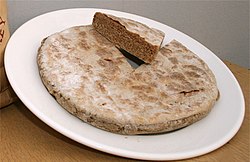Bannock (food)

|
|
| Type | Quick bread |
|---|---|
| Place of origin | Scotland |
| Region or state | North America, Shetland Islands |
| |
|
Bannock is a variety of flat quick bread or any large, round article baked or cooked from grain. When a round bannock is cut into wedges, the wedges are often called scones. However, in Scotland the words bannock and scone are often used interchangeably.
"Bannock" is a Northern English and Scottish word of Celtic origin. The Oxford English Dictionary states the term stems from panicium, a Latin word for "baked dough", or from panis, meaning bread. Its first cited use was in 1000, and its first cited definition in 1562. Its historic use was primarily in Ireland, Scotland and Northern England. The Scottish poet Robert Burns mentions the bannock in his Epistle to James Tennant of Glenconner, in reference to Alexander Tennant.
The original bannocks were heavy, flat cakes of unleavened barley or oatmeal dough formed into a round or oval shape, then cooked on a griddle (or girdle in Scots). In Scotland, before the 19th century, bannocks were cooked on a bannock stane (Scots for stone), a large, flat, rounded piece of sandstone, placed directly onto a fire, then used as a cooking surface. Most modern bannocks are made with baking powder or baking soda as a leavening agent, giving them a light and airy texture. There is a suggestion that bannock cakes played a pivotal role in the deciding of a person for human sacrifice during the late Iron Age in the discovery of Lindow Man.
Bannock varieties can be named or differentiated according to various characteristics: the flour or meal from which they are made, whether they are leavened or not, whether they have certain special ingredients, how they are baked or cooked, and the names of rituals or festivals in which they are used. Historically, specially made bannocks were used in rituals marking the changing of the Gaelic seasons: St Bride's bannock for spring (February 1), Bealtaine bannock for summer (May 1), Lughnasadh or Lammas bannock for autumn harvests (August 1), and Samhain bannock for winter (end of October). Other special Scottish and Gaelic bannocks include beremeal bannock, bride's bannock, cod liver bannock, cryin' bannock, fallaid bannock, fife bannock, Hogmanay bannock, Marymas bannock, mashlum bannock, Michaelmas Bannock, pease bannock, Pitcaithly bannock, salt bannock, sautie bannock, Silverweed bannock, St Columba's bannock, teethin' bannock, Yetholm bannock, and Yule bannock. In the north of England, bannocks are often made using pastry rather than a bread dough.
...
Wikipedia
